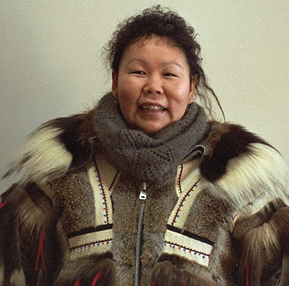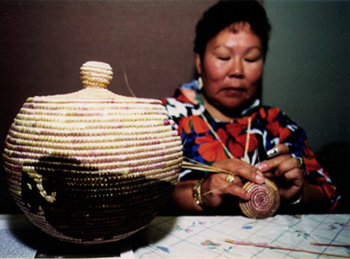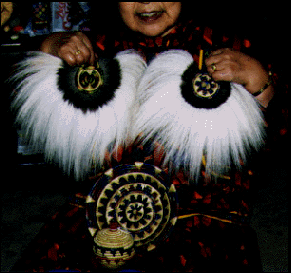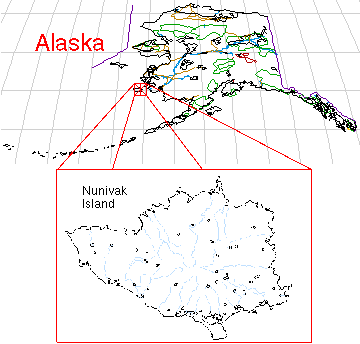 Hello,
my name is Emily Johnston. I am a full blooded Eskimo from Nunivak Island.
I make grass baskets, bowls, trays, and dance fans. In this picture I appear
in a traditional Squirrel Parka (Nunivak Island style) with a hand woven
Musk Ox (quiviut) smoke ring scarf. I am one of the only people I know
of who can also repair grass artifacts. I learned how to weave grass from
my grandmother Pansy, and my mother, Carrie. I weave in the traditional
Cup'ik (Choop'ik), or Nunivak Island, coil style. I try to use colors that
are mostly from berries, and quite a few other natural things, however
sometimes natural dyes are not available, so I have to substitute commercial
dyes. If a commercial dye is used I make sure the shade is correct by using
some natural dyed grasses as my reference. Each person has their own way
of making dyes that are held in secret and are rarely shared with others.
Hello,
my name is Emily Johnston. I am a full blooded Eskimo from Nunivak Island.
I make grass baskets, bowls, trays, and dance fans. In this picture I appear
in a traditional Squirrel Parka (Nunivak Island style) with a hand woven
Musk Ox (quiviut) smoke ring scarf. I am one of the only people I know
of who can also repair grass artifacts. I learned how to weave grass from
my grandmother Pansy, and my mother, Carrie. I weave in the traditional
Cup'ik (Choop'ik), or Nunivak Island, coil style. I try to use colors that
are mostly from berries, and quite a few other natural things, however
sometimes natural dyes are not available, so I have to substitute commercial
dyes. If a commercial dye is used I make sure the shade is correct by using
some natural dyed grasses as my reference. Each person has their own way
of making dyes that are held in secret and are rarely shared with others. In
a traditional Eskimo household the women, in addition to food preparation,
work skin and grass. Grass is important in both a practical and symbolic
sense and is used in lots of ways. Grass used to be woven into mats used
to cover sleeping platforms and to partition house space; it was also used
as seats in kayaks and large umiaks (walrus hide boats). Grasses were also
used to line subterranean storage pits preserving cached foods, and keeping
them from freezing to the soil. Grass was also stuffed into the bottoms
of boots forming soft pads, creating a layer of insulation between the
cold ground and peoples's feet, while also absorbing moisture, this is
very important when people spend a lot of time outside in the Arctic. If
a person is unlucky and falls into icy water on a cold day and is far away
from a camp or a village, their only chance of survival is to stuff their
clothes full of grass. The grass acts as an insulator preserving a persons
body heat while also keeping their clothes, which will freeze stiff as
boards, from touching their body and chilling them further. Grass was also
used to make bags and baskets for food, clothing, and personal things.
In
a traditional Eskimo household the women, in addition to food preparation,
work skin and grass. Grass is important in both a practical and symbolic
sense and is used in lots of ways. Grass used to be woven into mats used
to cover sleeping platforms and to partition house space; it was also used
as seats in kayaks and large umiaks (walrus hide boats). Grasses were also
used to line subterranean storage pits preserving cached foods, and keeping
them from freezing to the soil. Grass was also stuffed into the bottoms
of boots forming soft pads, creating a layer of insulation between the
cold ground and peoples's feet, while also absorbing moisture, this is
very important when people spend a lot of time outside in the Arctic. If
a person is unlucky and falls into icy water on a cold day and is far away
from a camp or a village, their only chance of survival is to stuff their
clothes full of grass. The grass acts as an insulator preserving a persons
body heat while also keeping their clothes, which will freeze stiff as
boards, from touching their body and chilling them further. Grass was also
used to make bags and baskets for food, clothing, and personal things. This
is me at my table during a show at the Alaska Federation of Natives confrence,
in 1997. In front of me you can see a finished Musk Ox basket, in the back
I am working on another basket. The Musk Ox design is one that has been
handed through my family ever since the Musk Ox were re-introduced to Nunivak
Island. I like to work with both grass and skins, but I mainly like to
make things from grass. I attend different arts and craft shows throughout
the year in Alaska.
This
is me at my table during a show at the Alaska Federation of Natives confrence,
in 1997. In front of me you can see a finished Musk Ox basket, in the back
I am working on another basket. The Musk Ox design is one that has been
handed through my family ever since the Musk Ox were re-introduced to Nunivak
Island. I like to work with both grass and skins, but I mainly like to
make things from grass. I attend different arts and craft shows throughout
the year in Alaska. This is my mother Carrie, who taught me most of what I know about weaving.
She is holding up two different styles of dance fans and in her lap there
is a platter and a basket.
This is my mother Carrie, who taught me most of what I know about weaving.
She is holding up two different styles of dance fans and in her lap there
is a platter and a basket.
At the mouth of the Yukon and Kuskoquim Rivers grow a slender kind of grass, Rye. Rye grass is gathered in the fall after the first frost and, sometimes, again in the spring where the last year's grass is collected, pulling or cutting it off close to the ground, and making large bundles which are carried home. The big bundles of grass are hung to dry. When the grass has dried, it is combed and hatcheled. This grass is dried and and carefully graded to be put to the correct use. Some grass is used for sewing, and is sometimes called wrapping grass, it is strong and flexible. The other grass that does not make the grade as wrapping, or sewing grass, is called filler grass and is used to provide form and structure for the article being made. Sedge is gathered in early August and October when it is ready. Its leaves are dried and used along with rye grass to make things. Sedge has a nicer coloring than does rye grass, and makes a more ornamental piece of work. Women use two weaving techniques that are common throughout the world, twining and coiling. I use the coil technique.
 Mekoryuk
is at the mouth of Shoal Bay on the north shore of Nunivak Island in the
Bering Sea. The Island is about 30 miles off the coast
See
Map of the region. It is about 155 miles west of Bethel. Nunivak
Island has been inhabited for 2,000 years by the Nuniwarmiut people, or
Cup'ik (Choop'ik) Eskimos. The first recorded outside contact was in 1821
by the Russian American Company, who said there were 400 people living
in some 16 villages on the Island. A little known fact is that the Nunivak
islanders have a form of pictograph writing that they use to record significant
events in the life of their people, it is almost a lost skill. An epidemic
in 1900 wiped out the population, leaving only four families alive. In
the 1930s, the Evangelical Covenant Church was built by an Eskimo missionary,
Jacob Kenick, at Mekoryuk, then a BIA school was built. Reindeer were introduced
as a commercial venture in 1920 by an Eskimo-Russian trader; the operation
is now run by the village IRA council. 34 musk ox from Greenland were transferred
to the Island in 1934 in an effort to save the species from extinction.
Today, the herd numbers around 500. An airstrip was built in 1957 and makes
travel to and from the Island easier and safer than a journey by boat.
Mekoryuk
is at the mouth of Shoal Bay on the north shore of Nunivak Island in the
Bering Sea. The Island is about 30 miles off the coast
See
Map of the region. It is about 155 miles west of Bethel. Nunivak
Island has been inhabited for 2,000 years by the Nuniwarmiut people, or
Cup'ik (Choop'ik) Eskimos. The first recorded outside contact was in 1821
by the Russian American Company, who said there were 400 people living
in some 16 villages on the Island. A little known fact is that the Nunivak
islanders have a form of pictograph writing that they use to record significant
events in the life of their people, it is almost a lost skill. An epidemic
in 1900 wiped out the population, leaving only four families alive. In
the 1930s, the Evangelical Covenant Church was built by an Eskimo missionary,
Jacob Kenick, at Mekoryuk, then a BIA school was built. Reindeer were introduced
as a commercial venture in 1920 by an Eskimo-Russian trader; the operation
is now run by the village IRA council. 34 musk ox from Greenland were transferred
to the Island in 1934 in an effort to save the species from extinction.
Today, the herd numbers around 500. An airstrip was built in 1957 and makes
travel to and from the Island easier and safer than a journey by boat.My next show is at The Diamond Center (in Conjunction with the Fur Rondy), Wednesday February 14th through Sunday the 18th.
Emily Johnston
P. O. Box 212164
Anchorage, Alaska 99521-2164